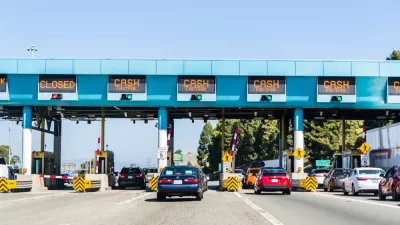To secure needed votes to pass a vital cap-and-trade bill, Brown made a deal with California's Republican lawmakers that could cost him his legacy infrastructure project—the high-speed train from Los Angeles to San Francisco.
The first part of the governor's strategy worked as seven Republican assembly members crossed party lines to support AB 398 by Assemblymember Eduardo Garcia (D-Coachella), the cap-and-trade bill the legislature settled on to extend the market-based system from 2020 to 2031, which barely made up for the five Democrats who did not support the bill [names of all 12 assembly members listed here by AP]. One Republican senator, Tom Berryhill of Twain Harte also supported the bill.
The landmark bill passed in each chamber on July 17 by one more vote than was required to reach a two-thirds supermajority to insulate cap-and-trade from potential litigation that carbon pricing is tantamount to a tax.
However, the bill was part of a 3-bill package that included a constitutional amendment, ACA 1 by Assembly Republican leader Chad Mayes of Yucca Valley, San Bernardino County, that will go before voters next June "that seeks to give the minority party more say over how the program’s money is spent," reports Kurtis Alexander for the San Francisco Chronicle. "The amendment calls for a one-time increase in the number of votes that the Legislature needs to approve how cap-and-trade money is spent, including the funds for the rail project."
That's the beleaguered $64 billion California high-speed rail project connect that almost all Republican lawmakers in California oppose and will go to extremes to stop, even though the the California High-Speed Rail Authority was created in 1996 under Gov. Pete Wilson and supported by Gov. Arnold Schwarzenegger, both Republicans.
“This absolutely calls into question the viability of high-speed rail going forward,” said Assemblyman Marc Steinorth, R-Rancho Cucamonga (San Bernardino County), who voted to extend cap and trade in part because of the proposed constitutional amendment. “If the bullet train can’t prove its worth, (this amendment) provides a pathway to ending the funding for the boondoggle once and for all.”
If voters support ACA 1 next June, the legislature in 2024 will have to secure a two-thirds supermajority to determine how to spend the revenue accrued from selling carbon allowances that year, unlike the expenditure plans for all other years between 2020 and 2031 that will need to pass by majority vote.
That could hand leverage to Republican legislators, if they can break the Democrats’ current two-thirds hold on both houses.
Opponents say that even though funding couldn’t be cut for another seven years, the uncertainty could be enough to prevent the rail authority from securing loans and investments needed to build the line.
Brown declined to comment on ACA 1, but pundits have speculated that "the climate program is so important to Brown that he was willing to take a calculated risk on other priorities, like high-speed rail," writes Alexander.
Since the first auction of carbon allowances in November 2012, about 25 percent of the revenues deposited into the Greenhouse Gas Reduction Fund go toward the rail authority. It is the project's only source of ongoing funding, as no private companies have stepped-in, though some have showed interest. The U.S. House Appropriations Committee included language in the transportation budget they passed on July 17 to prohibit federal funds for the California high-speed rail.
The third bill in the cap-and-trade legislative package is AB 617 by Assemblymembers Cristina Garcia (D-Bell Gardens) et.al. "to measure and combat air pollution at the neighborhood level - in communities most impacted," according to the governor's office.
Also see Los Angeles Times opinion on the gamble, "To save his climate change program, Jerry Brown sacrificed his bullet train," by editorial writer Kerry Cavanaugh.
FULL STORY: Brown’s cap-and-trade deal could eventually kill high-speed rail

Planetizen Federal Action Tracker
A weekly monitor of how Trump’s orders and actions are impacting planners and planning in America.

Restaurant Patios Were a Pandemic Win — Why Were They so Hard to Keep?
Social distancing requirements and changes in travel patterns prompted cities to pilot new uses for street and sidewalk space. Then it got complicated.

Maui's Vacation Rental Debate Turns Ugly
Verbal attacks, misinformation campaigns and fistfights plague a high-stakes debate to convert thousands of vacation rentals into long-term housing.

In California Battle of Housing vs. Environment, Housing Just Won
A new state law significantly limits the power of CEQA, an environmental review law that served as a powerful tool for blocking new development.

Boulder Eliminates Parking Minimums Citywide
Officials estimate the cost of building a single underground parking space at up to $100,000.

Orange County, Florida Adopts Largest US “Sprawl Repair” Code
The ‘Orange Code’ seeks to rectify decades of sprawl-inducing, car-oriented development.
Urban Design for Planners 1: Software Tools
This six-course series explores essential urban design concepts using open source software and equips planners with the tools they need to participate fully in the urban design process.
Planning for Universal Design
Learn the tools for implementing Universal Design in planning regulations.
Heyer Gruel & Associates PA
JM Goldson LLC
Custer County Colorado
City of Camden Redevelopment Agency
City of Astoria
Transportation Research & Education Center (TREC) at Portland State University
Jefferson Parish Government
Camden Redevelopment Agency
City of Claremont



























